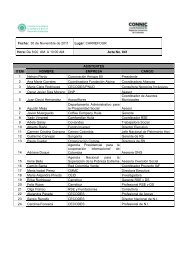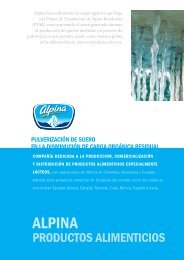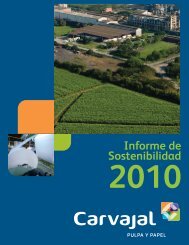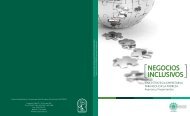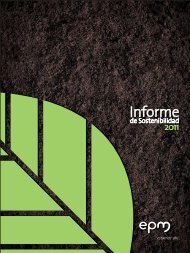Setting new standards - Friends Life
Setting new standards - Friends Life
Setting new standards - Friends Life
You also want an ePaper? Increase the reach of your titles
YUMPU automatically turns print PDFs into web optimized ePapers that Google loves.
FINANCIAL STATEMENTS<br />
IFRS FINANCIAL STATEMENTS<br />
EEV SUPPLEMENTARY INFORMATION<br />
Notes to the EEV results continued<br />
1. Methodology continued<br />
A market-consistent cost of financial options and guarantees and a<br />
market-consistent cost of holding required capital have also been<br />
calculated. The cost of financial options and guarantees includes<br />
additional allowance for non-market risk within the With-Profits<br />
Fund. An additional provision has been made for operational risks.<br />
These are described in more detail below.<br />
For presentational purposes, a set of risk discount rates has been<br />
derived for each product line, and for in-force and <strong>new</strong> business, by<br />
calculating the risk discount rate under a traditional embedded value<br />
approach that gives the same value as that from the marketconsistent<br />
embedded value determined above. These derived risk<br />
discount rates are a function of the assumptions used (eg equity risk<br />
premium, corporate bond spreads). However, as the marketconsistent<br />
approach is used, these assumptions do not impact the<br />
level of embedded value: a higher equity risk premium results in an<br />
exactly compensating higher risk discount rate.<br />
1.5 Financial options and guarantees<br />
The material financial options and guarantees are those in the<br />
<strong>Friends</strong> Provident <strong>Life</strong> and Pensions Limited (FPLP) With-Profits<br />
Fund, in the form of the benefits guaranteed to policyholders and<br />
the guaranteed annuity rates associated with certain policies.<br />
The risk to shareholders is that the assets of the With-Profits Fund<br />
are insufficient to meet these guarantees. While shareholders are<br />
entitled to only a small share of profits in the With-Profits Fund (via<br />
one ninth of the cost of bonus), they can potentially be exposed to<br />
the full cost if fund assets are insufficient to meet policyholder<br />
guarantees. The time value cost of this asymmetry, known as the<br />
burnthrough cost, is modelled stochastically, as it will only occur in<br />
some adverse scenarios. The burnthrough time value cost is<br />
calculated as the difference between the average value of<br />
shareholder cash flows under a number of market-consistent<br />
scenarios, and the intrinsic shareholder value using risk-free<br />
assumptions included within the deterministic model.<br />
The burnthrough cost has been assessed using a stochastic model<br />
derived from the current Realistic Balance Sheet (RBS) model. This<br />
model has been calibrated to market conditions at the valuation<br />
date. Allowance has been made under the different scenarios for<br />
management actions, such as altered investment strategy,<br />
consistent with the RBS model. The burnthrough cost would be<br />
markedly higher without the hedging activities undertaken.<br />
The burnthrough cost at 31 December 2006 of £50m (2005: £75m),<br />
is split between £30m (2005: £40m) market risk and £20m (2005:<br />
£35m) non-market risk. The non-market risks include lapses,<br />
annuitant longevity, and operational risk within the With-Profits Fund.<br />
The allowance for non-market risks is made by consideration of the<br />
impact of extreme scenarios from our economic capital model.<br />
Significant amounts of <strong>new</strong> with-profits business are no longer<br />
written and the guarantee levels offered are lower, hence there is no<br />
material impact of the burnthrough cost in the contribution to profits<br />
of <strong>new</strong> business.<br />
1.6 Required capital and the cost of capital<br />
Required capital is set at the greater of regulatory capital and<br />
economic capital. Regulatory minimum capital includes prudent<br />
reserves as well as solvency margin. Economic capital is determined<br />
from internal models, based on the Company’s risk appetite.<br />
At a product level economic capital requirements are higher than<br />
regulatory capital requirements for with-profits and annuity business,<br />
and lower than regulatory capital requirements on unit-linked and<br />
protection business. In aggregate, the economic capital<br />
requirements are higher than regulatory requirements by<br />
approximately £200m (2005: £100m).<br />
Capital requirements under EEV amounted to £652m (2005: £551m).<br />
For <strong>new</strong> business, regulatory capital requirements are higher than<br />
economic capital requirements, given the high proportion of unit-linked<br />
and protection <strong>new</strong> business, and the contribution to profits from <strong>new</strong><br />
business is therefore based on regulatory capital requirements.<br />
The EEV includes a deduction for the cost of holding the required<br />
capital. Frictional costs, being the tangible costs of holding capital,<br />
have been allowed for on a market-consistent basis. These consist<br />
of the total taxation and investment expenses incurred on locked-in<br />
shareholder capital and reflect the cost to an investor of holding an<br />
asset through investment in a life company, rather than investing in<br />
the asset directly.<br />
No adjustment has been made for any agency cost, this<br />
representing the potential markdown to value that investors will<br />
apply because they do not have direct control over their capital. Any<br />
adjustment would be subjective and different investors will have<br />
their own views of what adjustment, if any, should be made.<br />
1.7 Non-market risk<br />
An investor can diversify away the uncertainty around the return on<br />
non-market risks, such as mortality and expenses. Hence in a<br />
shareholder valuation the allowance for non-market risk is made<br />
through the appropriate choice of best estimate experience<br />
assumptions and the impact of non-market risks on the level, and<br />
hence the cost, of capital.<br />
In choosing best estimate assumptions the allowance for non-market<br />
risk has been reviewed. However, best estimate assumptions may<br />
fail to represent the full impact on shareholder value where the<br />
impact of fluctuations in experience is asymmetric; that is where<br />
adverse experience has a higher impact on shareholder value than<br />
favourable experience. The areas identified as having such<br />
asymmetries are the burnthrough cost and operational risk.<br />
170 <strong>Friends</strong> Provident Annual Report & Accounts 2006








